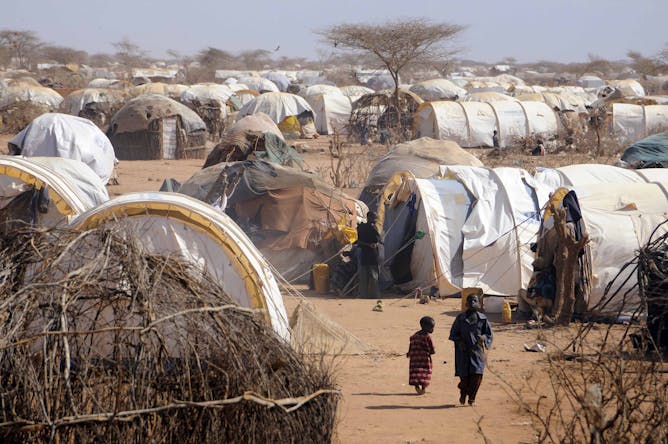|
Less than a year ago the world’s largest refugee camp, Dadaab in Kenya, was threatened with closure by the country’s government. Cristiano D'Orsi interviewed the UN Refugee Agency Ambassador Mohamed Abdi Affey, to find out what’s next for the camp and its inhabitants.
The Economic Community of West African States (Ecowas) has relied on agreements and announcements to meet its integration goals to operate beyond just words on paper. Karen Jackson, David Potts and Essa Bah explain why leaders should look to history for lessons on how to deepen unity.
For some background reading, find our special edition for the day on Africa’s fossils. Fossils add to our understanding of Earth’s ancient species and can help scientists make predictions about evolution and climate change, among other things. In our special edition, Lara Sciscio reveals how ancient footprints introduced researchers to a massive meat-eating dinosaur that once roamed Lesotho. Anne Austin traces the arduous commute of ancient Egyptian builders, showing how the journey was preserved in their bones, while Sandra
Jasinoski and Fernando Abdala explain that fossil evidence shows how our pre-mammalian ancestors nurtured their young.
|

People move around the outskirts of Dagahaley settlement at Kenya’s Dadaab Refugee Camp.
Reuters/Jonathan Ernst
Cristiano D'Orsi, University of Johannesburg
UN Refugee Agency special envoy Ambassador Mohamed Abdi Affey, explains what caused the reversal of the decision to close Dadaab, and what the future holds for Kenya's Somali refugees.
|
Politics + Society
|
-
Karen Jackson, University of Westminster; David Potts, University of Bradford; Essa Bah, University of Leeds
West Africa has lessons to learn from its ancient empires and colonial governments on regional trade and integration.
|
|
Business + Economy
|
-
Carin Runciman, University of Johannesburg
Proposed changes to South Africa's labour laws would make it almost impossible to strike and render the planned national minimum wage unenforceable.
|
|
Environment + Energy
|
-
David W. Olivier, University of the Witwatersrand
The water crisis in South Africa's Cape Town teaches us there's more at okay than just rainfall. Disasters like droughts involves seeing the issue from many different perspectives, including politics.
|
|

Kayentapus ambrokholohali footprints belong to an animal of about 26 feet long, dwarfing all the life around it.
Theropod image adapted by Lara Sciscio, with permission, from an illustration by Scott Hartman
Lara Sciscio, University of Cape Town
Until this discovery, theropod dinosaurs were thought to be considerably smaller, at three to five metres in body length, during the Early Jurassic.
|
|
|
-
Anne Austin, University of Missouri-St. Louis
Bones and texts showed how decades of strenuous hikes led to higher levels of osteoarthritis in workers' knees and ankles in an ancient Egyptian village.
-
Sandra Jasinoski, University of the Witwatersrand; Fernando Abdala, University of the Witwatersrand
Two fossils found in South Africa provide direct evidence of parental care in extinct pre-mammalian ancestors.
|
|
From our international editions
|
-
Dong Jin Kim, Trinity College Dublin
For a brief moment at the turn of the millennium, it seemed Seoul and Pyongyang were starting to open up to each other.
-
Brendan Cassidy, University of Central Lancashire; David Robinson, University of Central Lancashire
A Native American tribe in California got a chance to reconnect with their past through virtual reality models of inaccessible, sacred sites.
-
Subimal Chatterjee, Binghamton University, State University of New York
Why did most fans shun the prequel series, but embrace the recent spate of 'Star Wars' films? A recent study offers some clues.
|
|